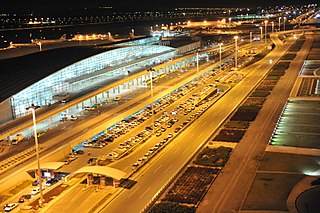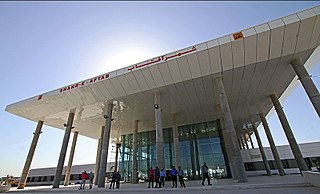
Tehran province is one of the 31 provinces of Iran. It covers an area of 18,814 square kilometres (7,264 sq mi) and is located to the north of the central plateau of Iran.

Imam Khomeini International Airport is the primary international airport of Tehran, the capital city of Iran, located 30 kilometres (19 mi) south of Tehran. All international flights in Tehran are currently served by this airport, and all domestic flights are served by Mehrabad Airport. IKA ranks third in terms of total passenger traffic in Iran after Mehrabad Airport and Mashhad International Airport. The airport is operated by the Iran Airports Company and is the primary operating base for Iran Air and Mahan Air, as well as an international hub for many smaller Iranian airlines.
Parand is a planned city in the Central District of Robat Karim County, Tehran province, Iran. Its toponym means "natural silk". Owned by the Parand family.

Valiasr Street, formerly known as the Pahlavi Street, is a tree-lined street in Tehran, dividing the metropolis into western and eastern parts which were built in 1922 to 1927 respectively, considering the end of asphalt plan it ended in 1933. It is considered one of Tehran's main thoroughfares and commercial centers. It is also the longest street in the Middle East, and was reported as one of the longest in the world by former BBC journalist Rageh Omaar during the television documentary Welcome to Tehran.

The Tehran Metro is a rapid transit system serving Tehran, the capital of Iran. It is the largest metro system in the Middle East. The system is owned and operated by Tehran Urban and Suburban Railway. It consists of six operational metro lines, with construction under way on four lines including northwestern extension of line 4, south extension line 6, north and east extension line 7 and Line 10.

Tajrish is a neighbourhood of Tehran, capital of Iran. Administratively it is in Shemiranat County, Tehran Province. It used to be a village and later was absorbed into the city of Tehran.
Gholhak is a neighborhood located in District 3 of Tehran Municipality. It is bounded on the east by the Darrous neighborhood, on the west by the Gholhak River, on the north by the British Embassy Garden, and on the south by the Pourmeshkani Street and Zafar Street (Dastgerdi).

The Porto Alegre Metro is a transit system operated jointly by the federal government, the state government of Rio Grande do Sul and the city of Porto Alegre through the company Trensurb in Brasil. It has 22 stations, totaling 43.8 kilometers (27.2 mi) of route, and carries about 175,000 users a day.

Haram-e Motahhar-e Emam Khomeini Metro station, formerly simply called Haram-e Motahhar Metro Station, is a station of Tehran Metro Line 1. The next station is Shahed - Bagher Shahr on the north side and Kahrizak on the south side. It is located east of Mausoleum of Khomeini.

Shahed - Bagher Shahr Metro Station is a station in Tehran Metro Line 1. It is between Haram-e Motahhar Metro Station and Palayeshgah Metro Station. It is located north of Behesht-e Zahra beside Northern Behesht-e Zahra Expressway.
Palyeshgah Metro Station is a station in Tehran Metro Line 1. It is located near Tehran Refinary, a town near Shahr-e-Rey on the southern outskirts of Tehran. It is Between Shahed - Bagher Shahr Metro Station and Shahr-e-Rey Metro Station.

Daneshgah-e Emam Ali Metro Station, which is translated into Imam Ali University Metro Station is a station in Tehran Metro Line 2. It is located in Imam Khomeini Street in front of the old Majles building near Imam Ali University. It is between Imam Khomeini Metro Station and Hor Square Metro Station. The station is named after Imam Ali University for Army Officers, which is located near the station on Imam Khomeini Street. The Assembly of Experts' building is also located next to this station.

The Panama Metro is a rapid transit system in Panama City, Panama. It links neighborhoods north and the east of the metropolitan area to the city center.

Tehran Metro Line 2, which opened between Sadeghieh and Imam Khomeini in February 2000, is 20.4 kilometers (12.7 mi) long, with 19 km (12 mi) as a subway and 1.4 kilometers (0.87 mi) elevated. At this time, there were 19 stations along the line, of which Imam Khomeini Station was shared by Line 1. Line 2 is coloured blue on system maps and runs mostly east–west through the city.

Line 4 is one of several lines of the Tehran Metro. The line is 24.4 km (15.2 mi) with 20 main stations, 3 stations along a domestic airport-serving branch line and a terminal (depôt).

The Tehran trolleybus system serves Tehran, the capital city of Iran. Opened in 1992, it is the only trolleybus system ever to have existed in Iran. At its maximum extent, the system had five routes, served by at least 65 trolleybuses. The system closed in 2013, but reopened in 2016 with one route and a fleet of around 30 modernised Škoda 15Tr.

Shahr-e Aftab Metro Station is a station in Tehran Metro Line 1. It is located in Aftab Rural District, near Behesht-e Zahra. The station serves Shahr-e Aftab Expo and Shahed University. The next station is on one end Shahed - Bagher Shahr Metro Station, towards Tehran city centre, and the other end Shahr-e Forudgahi-e Imam Khomeini Metro Station.

Emam Khomeini Airplane Metro Station, also referred to as Imam Khomeini Airport Metro Station, is a station on Tehran Metro Line 1, its extension. It is adjacent to Tehran Imam Khomeini International Airport. The station serves the airport and the surrounding, related facilities. Until 30 November 2023 it was the southern terminus of the line, when the extension towards Parand was inaugurated.















